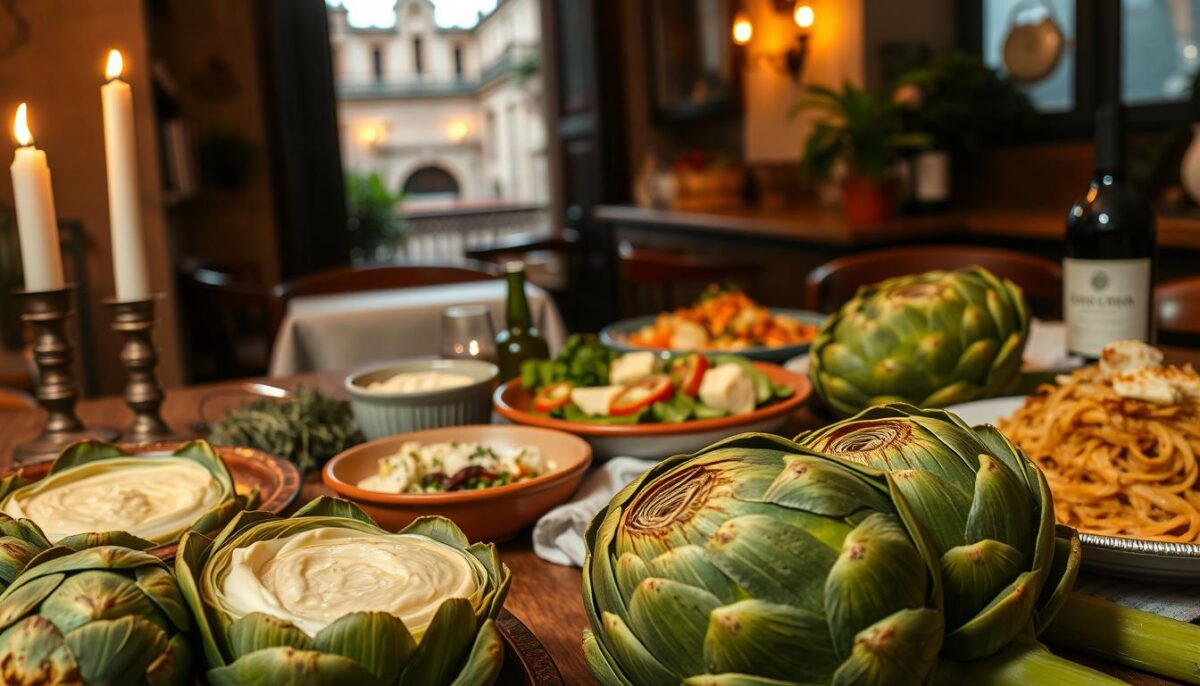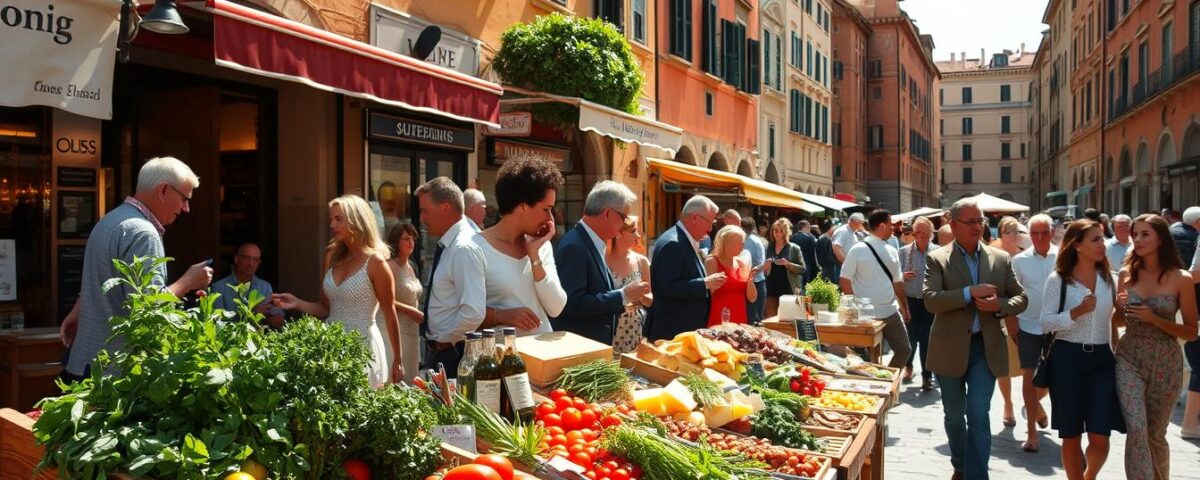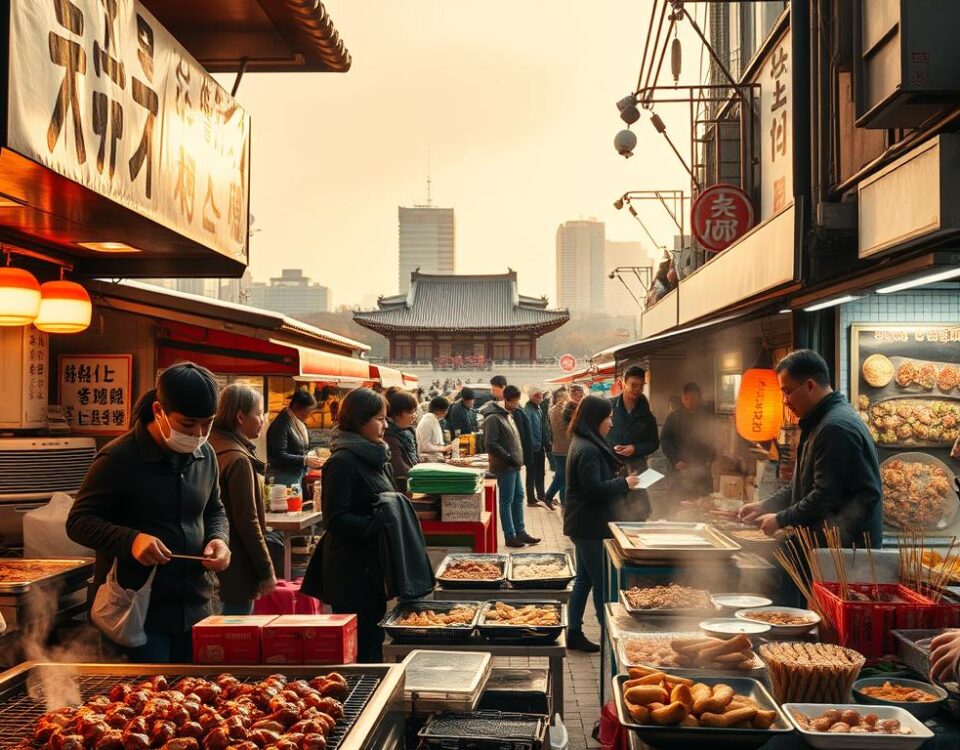
Top 6 Street Foods to Try in Hong Kong at Least Once
June 6, 20255 Iconic Snacks That Define a Trip to Barcelona
June 7, 2025Did you know 95% of visitors to Italy’s capital stick to the same 10 restaurants listed on travel apps? My first trip was no different—until a wrong turn led me to a family-run trattoria where Nonna Maria taught me the real magic of Roman cooking. That day, I tasted cacio e pepe so rich and peppery, it felt like biting into history itself.
Rome’s culinary scene isn’t just about pasta and gelato. It’s a living storybook where every dish whispers secrets from ancient markets and generations of home cooks. I’ve spent years exploring tucked-away osterias and chatting with butchers at Campo de’ Fiori, learning how simplicity creates the boldest flavors.
From crispy supplì fried to golden perfection to the tangy punch of maritati pizza bianca, this city turns meals into memories. I’ll never forget the joy of discovering a hole-in-the-wall bakery near the Pantheon, where flaky cornetto outshone every café I’d tried before.
Key Takeaways
- Rome’s best meals often hide in plain sight—look beyond tourist hubs.
- Historic recipes like carbonara remain unchanged for centuries.
- Local markets offer fresh ingredients central to traditional dishes.
- Conversations with chefs reveal the heart of Roman food culture.
- Seasonal menus highlight Italy’s farm-to-table philosophy.
Introduction: Discovering the Ultimate Rome Authentic Flavor Guide
Rome’s nickname “the eternal city” clicked for me when I tasted a centuries-old recipe in a dimly lit kitchen near Piazza Navona. The chef’s hands moved like clockwork—rolling dough, grating pecorino, whispering stories of emperors and olive groves. Time dissolves here, where every bite carries layers of history.
My first food crawl began by accident. I followed the aroma of roasted artichokes into a Jewish Ghetto alleyway, where locals debated the crispness of carciofi alla giudia. That’s when I realized: Roman food isn’t just meals—it’s how the people preserve their identity. Markets buzz with fifth-generation butchers explaining cuts, while grandmothers guard pasta secrets like national treasures.
To truly know this place, eat where the city eats. Skip the polished menus. Seek cramped tables where strangers become friends over shared wine carafes. You’ll taste why dishes like carbonara survived wars and trends—simple ingredients transformed by passion.
| Tradition | Innovation | Key Players |
|---|---|---|
| 2000-year-old recipes | Modern plating techniques | Family-run trattorias |
| Seasonal market staples | Fusion street food | Testaccio butchers |
| Wood-fired ovens | Vegetarian twists | Jewish Ghetto chefs |
This guide will walk you through crispy supplì pockets, silky cacio e pepe, and dishes that redefine “comfort food.” Whether you’re savoring tripe sandwiches at dawn or sipping local wines at sunset, you’re not just eating—you’re time-traveling. Ready to taste the eternal?
Exploring Iconic Roman Pastas
The first time I watched steam rise from a bowl of carbonara in a Testaccio kitchen, I understood why locals call pasta “the edible heartbeat of the city.” Each twirl of spaghetti tells stories older than the Colosseum, perfected through generations of simmering pans and shared secrets.
Pasta alla Carbonara and Its Rich History
I once asked a chef near the Tiber River why his carbonara tasted like liquid gold. “Guanciale fat and wartime ingenuity,” he grinned, explaining how American soldiers’ eggs met local cured pork in the 1940s. The magic lies in timing—tossing hot pasta with raw egg yolks and sharp pecorino creates a sauce so creamy, it clings to every ridge.
Pasta Variations: Gricia, Amatriciana, and Cacio e Pepe
Roman pastas form a delicious family tree. Gricia—carbonara’s simpler cousin—uses just guanciale and cheese. Amatriciana adds tomato tang from nearby hills. But cacio e pepe? That’s the Mona Lisa of pasta. I learned its peppery rhythm in a Trastevere alley, where a nonna demonstrated the wrist-flick needed to emulsify cheese without clumps.
Key differences:
- Gricia: Salty guanciale meets pecorino’s bite
- Amatriciana: Tomato brightness cuts through richness
- Cacio e Pepe: Pepper-forward simplicity perfected over centuries
These dishes aren’t just meals—they’re edible archives. Every forkful honors shepherds, farmers, and home cooks who turned scarcity into brilliance.
Roman Meat Dishes That Stand Out
My hands still remember the warmth of a cast-iron skillet in a Testaccio kitchen, where sizzling veal cutlets perfumed the air with sage and cured pork. Roman meat traditions turn simple cuts into symphonies—where every bite demands attention.
Saltimbocca: Veal, Prosciutto, and Sage
I discovered saltimbocca’s magic during a rain-soaked lunch near the Tiber. Paper-thin veal hugged salty prosciutto, while fresh sage leaves crackled under my fork. “The name means ‘jump in your mouth’,” the chef winked as I mopped up the wine sauce with crusty bread. This dish proves three ingredients can outshine entire menus.
Time-Honored Oxtail and Tripe Specialties
Locals schooled me on offal appreciation at a bustling mercado stall. Oxtail stew simmered for hours until the meat fell from the bone like molten gold. Across the counter, tripe tacos surprised me—tender strips in tomato sauce piled on charred flatbread. “Nothing wasted, everything celebrated,” the butcher declared, handing me a napkin dripping with garlicky juices.
What makes these courses unforgettable?
- Butchers age guanciale for months to intensify its smoky depth
- Wood-fired ovens transform tough cuts into butter-soft delights
- Family recipes pass through generations without compromise
Forget fancy plating. Here, meat mastery means honoring history through every simmer and sear. When your fork glides through braised oxtail, you’re tasting centuries of ingenuity.
Savoring Local Artichokes and Seasonal Vegetables
I nearly walked past the thorny green globes piled high at a market stall until a vendor thrust one into my hands. “Taste the spring,” he urged. That first bite of raw artichoke heart—bitter, grassy, alive—rewrote everything I knew about vegetables.

Carciofi alla Romana: Braised Delights
In a sunlit kitchen near Campo de’ Fiori, I learned why carciofi alla romana is called edible poetry. Cooks stuff trimmed artichokes with garlic and wild mint, then braise them upright in olive oil and white wine. “They drink like Romans,” the chef laughed as the liquid reduced to a fragrant broth. The result? Petals so tender they dissolve like whispered secrets.
Carciofi alla Giudia: Crispy Jewish-Style Artichokes
Crossing into the Jewish Quarter, I found artichokes reborn. Cooks deep-fry whole globes until golden, then press them open like chrysanthemums. The crunch gave way to a nutty sweetness I still dream about. Alla romana soothes, but alla giudia exhilarates—a perfect yin and yang of Roman cooking.
Seasonal produce drives menus here. Spring brings peas bright as emeralds, summer bursts with sun-kissed tomatoes, and autumn squash paints dishes orange. Local chefs treat vegetables as main events, not sides—each plate celebrating the dirt it grew in.
Want to taste centuries of tradition? Let artichokes guide you. Peel a petal. Savor the crunch. Feel history unfold on your tongue.
A Deep Dive Into Roman Street Food
The sizzle of frying oil and scent of fresh dough stopped me mid-stride near Campo de’ Fiori. Roman street food isn’t just fuel—it’s edible theater where crispy textures meet bold flavors. Locals queue at unmarked stalls clutching paper-wrapped treasures, their laughter mixing with the clatter of steel tongs.
Trapizzino: The Ultimate Pizza Pocket
I discovered my favorite on-the-go meal during a chaotic morning near Trastevere. Trapizzino combines airy pizza bianca with fillings like oxtail ragu or eggplant parmigiana. The first bite sent warm tomato sauce dribbling down my wrist—a delicious badge of honor.
Supplì: Bite-Sized, Flavor-Packed Rice Balls
Supplì taught me rice could be revolutionary. These golden spheres hide molten mozzarella cores within seasoned Arborio rice. Crunch through the fried shell, and you’ll find a cheese pull worthy of applause. I’ve devoured them while leaning against ancient walls, watching street vendors work their magic.
| Feature | Trapizzino | Supplì |
|---|---|---|
| Base Ingredient | Pizza dough triangle | Risotto rice |
| Signature Fillings | Braised meats, veggies | Tomato sauce, cheese |
| Texture Contrast | Crispy exterior, tender interior | Crunchy shell, creamy center |
| Serving Style | Handheld pouch | Bite-sized sphere |
| Meal Role | Hearty lunch option | Perfect snack |
What makes these street eats genius? They transform simple ingredients into portable feasts. A trapizzino stuffed with chicken cacciatore fueled my entire Vatican visit. Three supplì became dinner when I missed my reservation. This is food that adapts to your day—no silverware required.
Follow the locals. Seek carts with handwritten menus and oil-stained paper trays. When you taste that first supplì, you’ll understand why Roman street food outshines many sit-down meals. Just bring napkins—and curiosity.
Hidden Trattorias and Neighborhood Gems
Getting lost near Trastevere’s cobblestone alleys led me to a restaurant where handwritten menus hung beside faded family photos. The owner pressed a glass of homemade limoncello into my hand before I’d even ordered—a warm welcome that defines Roman neighborhood dining.
These family-operated spots thrive on intimacy. At a Testaccio hole-in-the-wall, Nonna Giulia taught me her secret for perfect amatriciana sauce: “Let the tomatoes argue with the guanciale until they make peace.” Her grandson translated while balancing plates of fried zucchini blossoms.
What makes these restaurants special? They’re living archives. Recipes scribbled on stained index cards. Chairs mismatched from decades of repairs. Menus changing daily based on market hauls. You’ll find more laughter than Wi-Fi passwords here.
Venture beyond Piazza Navona, and magic happens. A Jewish Ghetto neighborhood joint serves artichokes so tender, regulars trade cooking tips between bites. In Monti, fourth-generation butchers run a restaurant where steak arrives sizzling on cast-iron skillets—no frills, just fire and heritage.
These places don’t need websites. They thrive on word-of-mouth and the clatter of shared cutlery. Come hungry for connections as much as food. Leave with sauce-stained napkins and stories you’ll retell for years.
Exploring the Eternal City’s Local Markets and Seasonal Ingredients
A chorus of vendors haggling over wild mushrooms first revealed the city’s market soul to me. At dawn, Testaccio Market hums with energy—farmers unloading crates of purple artichokes, butchers sharpening knives behind marbled counters, and grandmothers sniffing ripe peaches like sommeliers. This is where Roman dishes begin their journey from soil to plate.
Foraged Finds: Fresh Vegetables, Zucchini Flowers, and More
Spring transforms market stalls into edible rainbows. I watched a vendor tuck delicate zucchini flowers into brown paper bags, their orange petals glowing like stained glass. “Cook them same day,” she advised, handing me a bundle tied with twine. Nearby, baskets overflowed with wild asparagus and bitter dandelion greens—ingredients most tourists never taste.
Seasonal shifts dictate menus here. Summer brings plump San Marzano tomatoes that burst like flavor bombs. Autumn showcases chestnuts and porcini mushrooms dusted with earthy grit. Winter? Think blood oranges so juicy, they stain your fingers crimson.
Insights from Testaccio and the Jewish Ghetto
At Testaccio Market’s wine stall, a fourth-generation seller taught me to pair wine with meals. “This sharp white cuts through fried artichokes,” he said, pouring a glass of Frascati. Across town in the Jewish Ghetto, I found stalls selling crisp flatbreads topped with anchovies—a perfect midday snack.
| Market Feature | Testaccio | Jewish Ghetto |
|---|---|---|
| Signature Item | Aged Pecorino Romano | Carciofi alla Giudia Kits |
| Best Time to Visit | 7-9 AM (Chef’s Hour) | 11 AM (Pre-Lunch Rush) |
| Local Secret | Homemade Porchetta | Stuffed Olives |
These markets offer more than ingredients—they’re classrooms. Watch nonnas debate olive oil viscosity. Taste cheese aged in volcanic caves. Smell bread baked in wood-fired ovens older than your great-grandparents. Every visit teaches something new about the world of Roman cooking.
Come hungry. Leave with a basket full of stories—and maybe a truffle or two.
The Evolution of Roman Cuisine: Tradition Meets Innovation
A marble countertop in Monti caught my eye—not for its elegance, but for the chef rolling pasta while explaining molecular gastronomy. This is today’s Roman cuisine: grandmothers’ recipes reimagined through modern lenses without losing their soul. Young chefs now balance heritage with curiosity, creating dishes that nod to history while whispering to tomorrow.
Contemporary Twists on Classic Dishes
At a sleek Trastevere eatery, I tasted carbonara transformed. The chef replaced guanciale with smoked tuna heart, pairing it with fermented black pepper. “Same technique, new story,” he said, showing how emulsion principles from ancient cooking endure. Another spot serves cacio e pepe dusted with nori flakes—a salty wink to coastal influences.
What makes these updates work? They honor the way ingredients interact. Vegan amatriciana uses sun-dried tomatoes and smoked paprika to mimic pork’s depth. A deconstructed supplì arrives as risotto croquettes with saffron aioli. These aren’t gimmicks—they’re conversations between eras.
| Traditional Element | Modern Twist | Purpose |
|---|---|---|
| Pecorino Romano | Aged in hay ash | Enhances earthy notes |
| Wood-fired ovens | Precision temperature control | Perfects crust texture |
| Hand-rolled pasta | 3D-printed molds | Creates sauce pockets |
Emerging chefs treat Roman dishes as living art. One told me, “We’re translators, not inventors.” Their menus read like love letters—experimental yet rooted. You’ll find tripe tacos with ancient spice blends, and gelato infused with basil from rooftop gardens.
This evolution feels natural. Nonnas approve revisions that respect their core principles. Diners savor surprises that still taste like home. The city’s cuisine isn’t frozen in time—it’s dancing, and everyone’s invited to join.
Experiencing Authentic Roman Dining
I still remember the night a chalkboard menu beckoned me into a vaulted cellar near Piazza Mattei. Waiters balanced trays of gnocchi while arguing about soccer with regulars. This wasn’t just a meal—it was dinner theater where strangers became friends through shared carafes of house red.
Local spots thrive on convivial chaos. At a Trastevere osteria, I squeezed between a retired carpenter and a university student at a communal table. Platters of saltimbocca circulated family-style, accompanied by boisterous debates about the perfect espresso foam.
Three elements define true Roman hospitality:
- Waiters who remember your wine preference from last visit
- Chefs emerging from kitchens to check if you want seconds
- Shared desserts with neighboring tables “just to compare”
Meals here unfold like culinary conversations. During my favorite dinner near the Pantheon, the owner sat down with my group, explaining how his grandfather taught him to roll pasta by moonlight. Visitors aren’t customers—they’re temporary family members.
Expect service that prioritizes connection over speed. Courses arrive when they’re ready, not according to schedules. Water glasses magically refill as you laugh over spilled olive oil. When the check comes, it’s often handwritten on a napkin—a final touch of homespun charm.
This is dining where time stretches like fresh mozzarella. Come hungry for stories. Leave with new friends and sauce-stained memories.
Local Tips for Savoring True Italian Flavors
I learned the city’s culinary rhythm through trial and error—like the time I arrived at a famed pasta spot at noon, only to find locals sipping espresso while kitchen staff prepped for lunch service. Timing transforms meals here. Let me show you how to sync your day with the local beat.

Best Times to Dine and Eat Like a Local
Early birds get stale bread. For the freshest cornetti, hit bakeries by 7:30 AM—before office crowds descend. Lunch peaks at 1:30 PM when workers flood family-run spots. Want a quiet table? Arrive at 12:45 or 2:15. Dinner’s a late-night affair—book after 8:30 PM for buzzing energy.
Insider Secrets and Restaurant Recommendations
Three rules I live by: 1) Order pasta at lunch (chefs use morning-market ingredients), 2) Seek places with menu chalkboards (daily specials beat printed lists), 3) Follow the nonne—grandmothers know which trattorias nail saltimbocca.
My favorite thing? A hidden osteria near San Giovanni where the owner grows basil on his rooftop. Ask for the “piatto del giorno”—you’ll get whatever his wife cooked that morning. Another gem: a hole-in-the-wall near Ponte Milvio serving supplì with unexpected fillings like truffled mushrooms.
Pro tip: Mid-afternoon snacks beat crowds. Grab a thing Romans call “merenda”—maybe a slice of pizza bianca from Forno Roscioli around 4 PM. It’s the perfect day bridge between lunch and late dinners.
Sipping on Local Wines and Beverages
My first Roman sunset found me clutching a wineglass near a vineyard outside Frascati, watching golden light dance across rolling hills. A vintner handed me olive-stuffed bread with my pour. “The oil cuts through tannins,” he explained as cherry notes from the red blend bloomed on my tongue.
Local wines here aren’t just drinks—they’re conversation partners. A sommelier near Trastevere taught me to swirl cesanese while inhaling oregano-scented air from the kitchen. “Wine mirrors the meal’s heartbeat,” she said, pairing peppery pasta with earthy Lazio reds.
| Wine Type | Perfect Pairing | Olive Oil Twist |
|---|---|---|
| Frascati Superiore | Fried artichokes | Drizzle lemon-infused oil post-fry |
| Cesanese del Piglio | Wild boar ragu | Finish sauce with smoked oil |
| Grechetto Bianco | Saltimbocca | Basil oil in sage butter |
Discover hidden enotecas where oil plays bartender. One spot near Campo de’ Fiori shakes up olive-infused vermouth with rosemary syrup. Another serves white wine spritzers topped with oil foam—a velvety contrast to crisp bubbles.
For the truest sips, visit family-run cellars in Castelli Romani. They’ll pour glasses beside barrels while sharing stories of ancient presses. You’ll taste how oil’s grassy notes elevate even house wines. Leave with bottles wrapped in paper—and a new appreciation for liquid craftsmanship.
Simple Cooking at Home: Recreating Roman Classics
I never thought my tiny kitchen could rival a Roman trattoria until I mastered the art of simplicity. With just a handful of quality ingredients and time-tested techniques, I discovered how to channel the city’s culinary soul into everyday meals. Home cooking becomes a passport when you let sharp pecorino and cracked pepper lead the dance.
Essential Ingredients and Techniques
Start with the holy trinity of Roman pantries: guanciale, aged pecorino, and bronze-cut pasta. A chef once told me, “Your pan is your best teacher—listen to how the cheese melts.” For carbonara, toss piping-hot spaghetti with egg yolks off the heat to create that silky sauce without scrambling. No fancy tools needed—just a wooden spoon and patience.
Morning cravings? Bring Roman flair to your breakfast table. Dip flaky cornetto in espresso dusted with cocoa, or spread ricotta on toasted pane casareccio with fig jam. My go-to? Fried eggs drizzled with olive oil and a pinch of rosemary—a rustic nod to countryside kitchens.
Three rules for success:
- Source ingredients locally (try pancetta if guanciale’s unavailable)
- Cook pasta al dente—it should snap like a fresh celery stalk
- Finish dishes with a raw egg yolk or citrus zest for brightness
Last week, I whipped up cacio e pepe while my coffee brewed. The trick? Reserve starchy pasta water to emulsify the cheese. As steam curled around my home kitchen, I realized: Roman magic isn’t confined to cobblestone streets. It’s wherever you honor simplicity with gusto.
Detailed Rome authentic flavor guide: Exploring the Eternal City Through Its Food
Cracking open a carciofi alla romana revealed more than tender leaves—it unfolded a culinary map etched by generations of Roman cooks. Every ingredient here serves dual purposes: pecorino adds saltiness and emulsifies sauces, while guanciale fat becomes both flavor base and textural magic.
Two preparation styles define artichoke mastery:
| Style | Technique | Key Ingredients |
|---|---|---|
| Carciofi alla Romana | Braising in white wine | Wild mint, garlic |
| Carciofi alla Giudia | Deep-frying whole | Lemon, olive oil |
Modern chefs honor these roots while experimenting. I recently tasted carciofi alla carbonara—shaved artichokes replacing pasta in a creamy egg sauce. Yet the soul remains: dishes rely on ingredients so fresh, they dictate menus daily.
Three rules for culinary exploration:
- Seek places where ingredients star (markets > restaurants)
- Ask “Qual’è il piatto del territorio?” (What’s the regional specialty?)
- Pair meals with stories—every bite tastes richer with context
The eternal city’s secret? Treating ingredients as living history. At Testaccio Market, I learned aged pecorino develops crystalline textures that melt differently in sauces. This knowledge transforms iconic pasta variations from meals to time capsules.
My favorite discovery? A deli near the Pantheon serving carciofi alla sandwiches on wood-fired bread. Each crunch echoed centuries of culinary evolution—proof that tradition and innovation feed each other here.
Conclusion
My culinary journey through backstreets and bustling markets revealed a truth: Roman cooking thrives where tradition shakes hands with curiosity. Those golden artichokes fried to crackling perfection? They’re edible time capsules. The sharp tang of pecorino in your cacio e pepe? That’s centuries of cheesemaking wisdom melting on your tongue.
From family kitchens guarding pasta secrets to innovative chefs reimagining ancient cheeses, every bite tells a story. I’ll never forget supplì crunching under Roman moonlight or the way braised oxtail warmed my hands on a chilly evening.
Let this be your invitation. Wander beyond glossy menus. Taste where locals debate olive oil brands over espresso. Whether you’re savoring carciofi alla giudia or discovering new twists on classics, remember—every meal here bridges past and present.
Pack stretchy pants and an open mind. Your own delicious adventure awaits, one crispy rice ball and silky pasta strand at a time. Trust me—your palate will thank you.
FAQ
What pasta dishes should I prioritize trying in Rome?
Don’t miss classics like cacio e pepe (cheese and pepper), amatriciana (tomato and guanciale), and carbonara. Each has a unique history tied to the Eternal City’s working-class roots. Pair them with a glass of local Lazio wine!
Where can I find the best street food beyond pizza?
Head to Testaccio Market for supplì (fried rice balls) or try a trapizzino—a pizza pocket stuffed with oxtail or tripe. For crispy carciofi alla giudia (Jewish-style artichokes), explore the Jewish Ghetto’s cozy eateries.
How do I avoid tourist traps when dining out?
Look for family-run trattorias in neighborhoods like Trastevere or Monti. Menus with daily specials featuring seasonal veggies (like zucchini flowers) are a good sign. If they serve saltimbocca with fresh sage, you’re in the right place!
What’s a unique meat dish I shouldn’t skip?
Try coda alla vaccinara (braised oxtail) or trippa alla romana (tripe in tomato sauce). These hearty dishes reflect Rome’s tradition of “nose-to-tail” cooking and are often served in old-school spots like Da Felice.
Can I recreate Roman dishes at home?
Absolutely! Focus on quality ingredients: pecorino romano, guanciale, and extra-virgin olive oil. Master simple techniques—like emulsifying pasta water into cheese—and you’ll nail classics like gricia or carciofi alla romana (braised artichokes).
Are there vegetarian-friendly options?
Yes! Seasonal veggies shine here. Try puntarelle (chicory salad) with anchovy dressing or stuffed zucchini flowers. Even iconic pastas like cacio e pepe are vegetarian—just skip the meat-based additions.
What’s the best time to enjoy dinner like a local?
Romans eat late! Book dinner after 8 PM for a lively atmosphere. For lunch, grab a quick panino (sandwich) with porchetta at Mercato Centrale or linger over a long midday meal at a trattoria.



